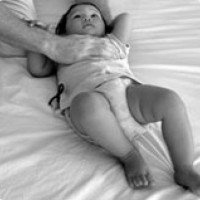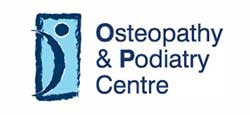 Osteopathy is an effective and natural approach to healthcare for all life stages. Osteopaths treat babies and children for a variety of common complaints, and to ensure healthy postural development.
Osteopathy is an effective and natural approach to healthcare for all life stages. Osteopaths treat babies and children for a variety of common complaints, and to ensure healthy postural development.
Can osteopathy help my child?
Many common problems suffered by babies and children can be managed effectively with osteopathy.
Problems often suffered by babies:
- crying and irritability, especially when lying down.
- feeding difficulties.
- sickness, colic and wind, constipation.
- sleep disturbances.
Problems often suffered by older children:
- musculo-skeletal problems - growing pains, scoliosis, kyphosis/lordosis, Osgood Schlatters/Chondromalacia Patella
- recurrent ear infection, sometimes with a loss of hearing and 'glue ear'.
- sinus problems, with a constantly blocked or runny nose.
- headache.
- asthma and vulnerability to chest infections.
Could my child suffer an adverse reaction to osteopathy?
Often, after the consultation the baby or child is very relaxed and sleeps well. Others have a burst of energy, and then have a good night's sleep. Occasionally children feel unsettled, but this is a temporary situation that happens when mechanical changes are occurring, and only lasts for a day or two.
At what age should my child be treated?
Children of any age can benefit from osteopathy. It is never too early to start, and for best results management should begin before the age of five.
Osteopathy for babies and toddlers
Many of the problems that babies and children suffer are caused before, during and immediately after birth, and the child may be left with uncomfortable stresses within its head and body. These stresses can lead to problems such as suckling and latching-on difficulties, irritability, colic, wind and disturbed sleep patterns. Toddlers may suffer from difficulties with mobility and play, and they may sit, crawl and walk early, seeking movement to relieve physical discomfort.
Sleep patterns are disturbed, teething may be uncomfortable and head banging or pulling at the hair may occur.
Osteopathic management can bring about significant improvement in these cases, and has particular success with the problems suffered by premature babies. These babies inevitably suffer stresses and trauma during birth and then further stress from the equipment that needs to be used to stabilise their condition.
Osteopathy for children and teenagers
Distortions to the head can continue to hinder the growth and development of a child's brain as it grows older. The child's behaviour may be volatile, and they may have problems with coordination and physical development. They may be vulnerable to chronic ear infections, glue ear, headaches, growing pains and stomach aches. The child's posture may suffer too, with the head being held on one side, or one shoulder held higher than the other.
During the teenage years, the body frame undergoes a number of changes. Problems may occur because of an exaggerated spinal curve or because of mechanical changes that occur through osteochondritis - a self-limiting condition that causes a distortion of the bone. Other problems are caused by sporting and recreational activities that carry the risk of sprains and strains.
If these problems are left undiagnosed and untreated they can worsen in later life. Osteopaths can help the body frame adjust to the postural demands made on it. By analysing, treating and managing problems associated with growth, osteopaths make a major contribution to ensuring that young people stay fit and healthy.
Problems suffered by babies:
- Irritable gut. When the milk passes through to the small intestine too quickly prior to being broken down in the stomach it can irritate the gut. This will give the baby a distended windy abdomen and the baby may look like it is pushing all the time to try and get rid of the wind. When the milk passes into the small intestine having travelled through the stomach too quickly without being broken down fully it can irritate the gut. This leads to a distended abdomen and the baby may look like it is pushing all the time to try and get rid of the wind. Osteopathy involves palpating the gut and using gentle techniques to help expel the wind and promote bowel movement. Our osteopaths can also work on the head, neck and mouth to stimulate a branch of the vagus nerve which supplies the gut. Exercises and stretches are sometimes prescribe and taught to the parents to perform at home to help prevent re-occurance.
- Constipation – At 6 weeks the peak time for colic, a baby may become constipated as the bowel slows down from opening from 6-8 times per day to 1-2 per day. Some babies may get constipated and the bowels do not open for a few days causing a lot of discomfort and irritability. . This can lead to constipation and the bowels not opening for several days resulting in discomfort and irritability. Osteopathic management involves palpating the gut and using gentle techniques to help promote bowel movement. Our osteopaths can also work on the head, neck and mouth to stimulate a branch of the vagus nerve which supplies the gut. Exercises and stretches are sometimes prescribe and taught to the parents to perform at home to help prevent re-occurrence.
- Poor feeding/latching – this may occur with a baby who has a tongue tie or a latching problem, where the baby is bringing in a lot of wind whilst it is suckling at the breast or the bottle and not drinking enough milk. Babies who have tongue tie and difficulty latching can take in a lot of wind whilst suckling at the breast and the bottle. This can also reduce the amount of milk that they are able to consume. Our osteopaths work on the head, neck and mouth, on the vagus and phrenic nerves which supply the gut and the diaphragm. The osteopath will gently release restrictions in the neck and around the jaw allowing the baby to suckle more easily bringing in less wind. Our osteopaths have close working relationships with lactation consultants to help the mothers achieve successful and pain free feeding. Osteopathic cranial therapy for lactation:
The head, neck and mouth are worked on as there is a branch of the vagus nerve which supplies the gut and the nerves to the diaphragm are supplied by the neck. Osteopathy will gently release restrictions in the neck and around the jaw allowing the baby to suckle more easily bringing in less wind. - Mastitis – Mastitis occurs when the milk ducts become blocked and do not clear. The milk collected in the blocked duct can be forced into the surrounding area of breast causing pain and inflammation. Symptoms can be flu like including a low grade temperature and possible infection of the breast tissue. Mastitis can be treated with gentle massage and ultrasound. The ultrasound machine will deliver high impact sound waves making a vibration and provides a micro-massage to the breast tissue which unclogs the ducts and helps to reduce swelling and pain
| The content on this website is provided for general information only. Diagnosis & management of an individual's medical condition requires proper examination by and consultation with a qualified practitioner |
To book an appointment call +65 6734 4236 or book an appointment online here

